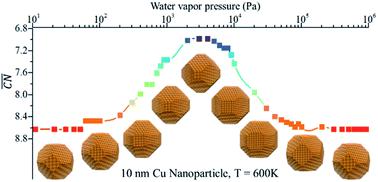当前位置:
X-MOL 学术
›
Faraday Discuss.
›
论文详情
Our official English website, www.x-mol.net, welcomes your
feedback! (Note: you will need to create a separate account there.)
Structure reconstruction of metal/alloy in reaction conditions: a volcano curve?
Faraday Discussions ( IF 3.3 ) Pub Date : 2020-1-20 , DOI: 10.1039/c9fd00128j Jun Meng 1, 2, 3, 4, 5 , Beien Zhu 1, 2, 3, 4, 6 , Yi Gao 1, 2, 3, 4, 6
Faraday Discussions ( IF 3.3 ) Pub Date : 2020-1-20 , DOI: 10.1039/c9fd00128j Jun Meng 1, 2, 3, 4, 5 , Beien Zhu 1, 2, 3, 4, 6 , Yi Gao 1, 2, 3, 4, 6
Affiliation

|
Recent in situ works have shown extensive evidence of the dramatic and reversible structure reconstructions of metal and alloy materials in reaction conditions. The reconstructions are of primary interest because they could lead to alternative catalytic mechanisms during real reactions. However, how the catalyst structure evolves under the pressures relevant to industrial applications (>1 atm) is so far unexplored. In our recent works, we have developed multiscale theoretical models to give reliable and precise predictions of the equilibrium shapes of metal nanoparticles and of the segregation properties of alloy surfaces at a given temperature and gas pressure. The theoretical predictions have been successfully used in interoperations of various in situ experimental observations. In this work, we applied these methods to study the detailed structural information of metal NPs and of bimetallic alloys at the temperature from 300 to 1000 K and the gas pressure from 10 to 107 Pa. The results show, in some cases, both the gas-induced shape change and the gas-induced segregation change are maximized when the gas adsorption is ‘just right’. The fraction of the low-coordinated sites of the metal NP shows a volcano-like curve with pressure at a constant temperature. A similar volcano shape could also be found in the plot of the environmental segregation energy as functions of temperature and pressure. The similar gas effects at low pressure and at high pressure indicate the structural information obtained in laboratory environments (<1 atm) could be of use to understanding the catalysts structure reconstruction in industrial conditions (>1 atm).
中文翻译:

反应条件下金属/合金的结构重建:火山曲线?
最近的现场工作显示了在反应条件下金属和合金材料的戏剧性和可逆结构重构的大量证据。重建是主要关注的问题,因为它们可能导致在实际反应过程中产生其他催化机制。然而,迄今为止还没有探索催化剂结构在与工业应用相关的压力(> 1atm)下如何演变。在我们最近的工作中,我们已经开发了多尺度理论模型,可以在给定温度和气压下对金属纳米颗粒的平衡形状以及合金表面的偏析特性进行可靠而精确的预测。理论预测已成功地用于各种现场互操作中实验观察。在这项工作中,我们应用这些方法研究了温度为300至1000 K,气压为10至10 7的金属NP和双金属合金的详细结构信息。Pa。结果表明,在某些情况下,当气体吸附“恰到好处”时,气体引起的形状变化和气体引起的偏析变化都达到最大。在恒定温度下,金属NP的低配位部位的分数显示出类似火山的曲线。在环境隔离能与温度和压力的函数关系图中,也可以找到类似的火山形状。低压和高压下类似的气体效应表明,在实验室环境(<1 atm)中获得的结构信息可用于理解工业条件(> 1 atm)中催化剂的结构重建。
更新日期:2020-01-20
中文翻译:

反应条件下金属/合金的结构重建:火山曲线?
最近的现场工作显示了在反应条件下金属和合金材料的戏剧性和可逆结构重构的大量证据。重建是主要关注的问题,因为它们可能导致在实际反应过程中产生其他催化机制。然而,迄今为止还没有探索催化剂结构在与工业应用相关的压力(> 1atm)下如何演变。在我们最近的工作中,我们已经开发了多尺度理论模型,可以在给定温度和气压下对金属纳米颗粒的平衡形状以及合金表面的偏析特性进行可靠而精确的预测。理论预测已成功地用于各种现场互操作中实验观察。在这项工作中,我们应用这些方法研究了温度为300至1000 K,气压为10至10 7的金属NP和双金属合金的详细结构信息。Pa。结果表明,在某些情况下,当气体吸附“恰到好处”时,气体引起的形状变化和气体引起的偏析变化都达到最大。在恒定温度下,金属NP的低配位部位的分数显示出类似火山的曲线。在环境隔离能与温度和压力的函数关系图中,也可以找到类似的火山形状。低压和高压下类似的气体效应表明,在实验室环境(<1 atm)中获得的结构信息可用于理解工业条件(> 1 atm)中催化剂的结构重建。











































 京公网安备 11010802027423号
京公网安备 11010802027423号